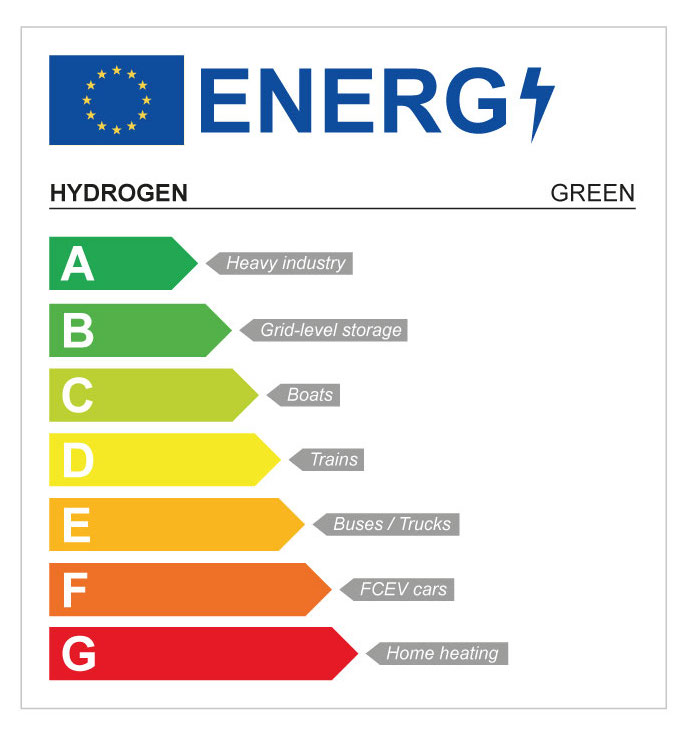Where should green hydrogen fit in your city?
A short guide to where we think hydrogen can make the biggest impact in a city's energy transition.
Hydrogen is being touted as a solution to many challenges in the energy transition. And it is an exciting and flexible energy carrier that will be key to the EU’s goals of energy system integration. But hydrogen is clearly better suited to some challenges more than others. This is a guide of where we think it will fit best in cities but much will depend on how the technology and its costs evolve compared to other decarbonised solutions. Specific local conditions like access to large amounts of renewable energy, industrial hubs and geological formations for large-scale storage will also dictate where and when green hydrogen makes sense. For a more complete overview on hydrogen this article by Carbon Brief is excellent.
We haven’t looked at two much-touted uses of green hydrogen, maritime shipping and aviation, as these fall outside of what cities can generally control.

Image © Energy Cities
Heavy Industry:
The closest thing to a consensus about hydrogen is that it’s greatest potential is the decarbonisation of heavy industry – especially steel but also refineries, cement, ceramics and chemicals. Essentially, any industry that needs extremely high temperatures. Some of these industries could be electrified but that would require a big investment in completely new equipment whereas green hydrogen could serve as an almost direct replacement for coal and gas.
Grid-level storage:
One of the biggest challenges of a renewable electricity grid is the difference between summer and winter generation – especially as you go further north. Creating green hydrogen from ample solar generation in summer (or wind when demand is low) for use in the winter is one possible solution (Michael Liebreich of BNEF runs through some numbers here). Electricity from green hydrogen will have a much higher marginal cost. But this is less important for three reasons:
1) Overall system costs of a largely renewable grid should be lower
2) All intermittent energy sources such as gas peaker plants have higher marginal costs
3) Electricity from green hydrogen is seen as a solution for the ‘last mile’ of grid decarbonisation – a cold and windless week in January – and not a substantial player in the grid year-round.
Transport: This is where they hydrogen hype train really starts to roll.
Boats: Big or small, hydrogen and electric battery boats are coming. The trade-off between the space needed for hydrogen and the weight of batteries as well as use patterns will play a big role in determining which technology might work best. Ports also look like a likely spot for the development of hydrogen hubs so hydrogen might prove quite popular on the water.
Trains: Trains must be the most prominent electrified transportation option – normally with overhead wires. But where overhead wires aren’t cost-effective, or possible, there are more and more hydrogen powered trains as well as combined battery/hydrogen trains and lots of battery electric trains. All of these options will likely co-exist for decades to come as different distances and use patterns (not to mention accessibility of green hydrogen) make one option preferrable to the others.
Buses: Battery-electric and hydrogen fuel cell buses are spreading rapidly in Europe although still lagging far behind China where 99% of the world’s electric buses can be found. Both models have zero tailpipe emissions, helping address local air pollution. But the mass manufacture of electric buses, easier infrastructure investments and avoiding the energy loss of electrolysis means battery electric buses should be preferred. Hydrogen fuel cell buses do have the advantage of rapid refuelling but with sufficient range electric buses can be charged overnight and those large batteries can play an important role in meeting demand peaks with vehicle-to-grid technology.
Local heavy duty (cargo/garbage trucks): Here we see a clear benefit for electric trucks over hydrogen fuel cell vehicles. The range is easily covered by today’s batteries and with big commercial manufacturers now involved life is simpler and easier with a battery-electric vehicle. As with buses the infrastructure is easier, and the prospect of vehicle-to-grid technologies in the future mean the financial equation will only get better.
FCEV (cars and light trucks): This is a big no for hydrogen. There is a reason most of the EU’s car manufacturers have bowed out of the hydrogen market. Battery electric vehicles are much further along in their development, available in a wide variety of styles and price points and the availability of green hydrogen as a cheap commodity is decades away.
New research from Transport and Environment “shows that powering just a fraction of vehicles with e-fuels (including e-diesel and hydrogen) in 2050 would require new offshore wind-farms covering an area the size of Denmark.”
Home heating: There’s an appealing logic to using hydrogen in home heating. Just inject a little into the gas mix and emissions go down without any disruption. Unfortunately, most experts are quite clear this is a bad idea.
This study’s findings are clear: hydrogen is not a viable option when it comes to heating buildings. The amount of green electricity needed to produce green hydrogen for this purpose is 500 to 600 percent greater than the amount needed to power an equivalent number of heat pumps.
“The differences in efficiency are so large that it is unreasonable to propose the wide-spread use of hydrogen for heat in buildings,” Prof. Dr. Clemens Hoffmann, the Executive Director of Fraunhofer IEE, says.
In The Times Emily Gosden reports that switching all gas boilers to hydrogen in the UK “would need 30 times as much offshore wind farm capacity.”
Jan Rosenow also points out that when it comes to heating with hydrogen ‘Centrica, the world’s oldest and Britain’s largest gas utility, recently said “domestic hydrogen use is likely more than ten years away, with the costs to customers as yet unknown”.’
Finally, the less said about hydrogen fuel cell bikes the better…
